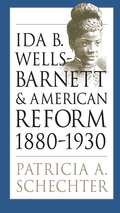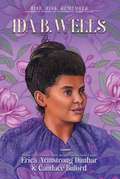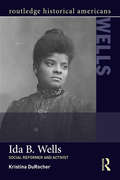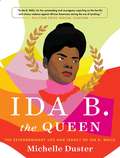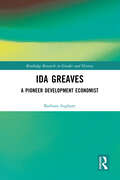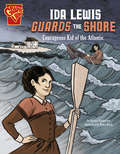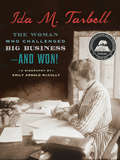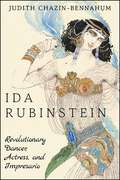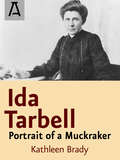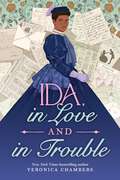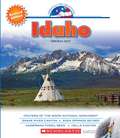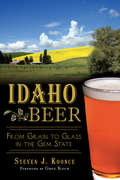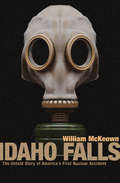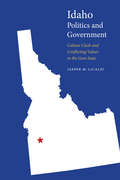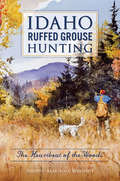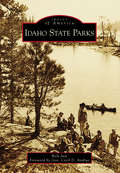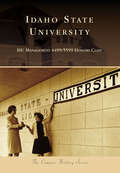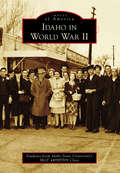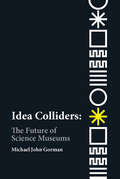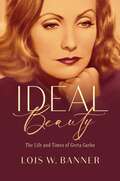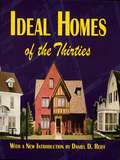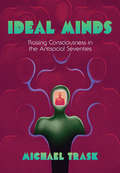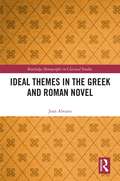- Table View
- List View
Ida B. Wells-Barnett and American Reform, 1880-1930
by Patricia A. SchechterPioneering African American journalist Ida B. Wells-Barnett (1862-1931) is widely remembered for her courageous antilynching crusade in the 1890s; the full range of her struggles against injustice is not as well known. With this book, Patricia Schechter restores Wells-Barnett to her central, if embattled, place in the early reform movements for civil rights, women's suffrage, and Progressivism in the United States and abroad. Schechter's comprehensive treatment makes vivid the scope of Wells-Barnett's contributions and examines why the political philosophy and leadership of this extraordinary activist eventually became marginalized. Though forced into the shadow of black male leaders such as W. E. B. Du Bois and Booker T. Washington and misunderstood and then ignored by white women reformers such as Frances E. Willard and Jane Addams, Wells-Barnett nevertheless successfully enacted a religiously inspired, female-centered, and intensely political vision of social betterment and empowerment for African American communities throughout her adult years. By analyzing her ideas and activism in fresh sharpness and detail, Schechter exposes the promise and limits of social change by and for black women during an especially violent yet hopeful era in U.S. history.
Ida B. Wells: Journalist, Advocate & Crusader for Justice (Rise. Risk. Remember. Incredible Stories of Courageous Black Women)
by Erica Armstrong Dunbar Candace BufordMeet journalist and activist Ida B. Wells in this second vibrant middle grade biography in the Rise. Risk. Remember. Incredible Stories series spotlighting Black women who left their mark on history from acclaimed and New York Times bestselling author Erica Armstrong Dunbar and Candace Buford.Born into slavery, Ida B. Wells (1862–1931) grew up watching her family fight for Black rights during the Reconstruction Era. After receiving her education, Ida worked as an educator before moving to Memphis where she began writing about white mob violence, investigating lynchings and reporting her findings in local newspapers. Ida helped found the NAACP and was a renowned leader in the civil rights movement, but she was also a young woman desperately trying to hold her family together after tragedy with dignity and resolve. Ida fought to give voice to the people suffering from injustice, racism, and violence. She spoke out against lynchings internationally and refused to cater to the white women leading the suffrage movement. Throughout her life, she devoted her words and deeds to activism.
Ida B. Wells: Social Activist and Reformer (Routledge Historical Americans)
by Kristina DuRocherBorn into slavery in 1862, Ida B. Wells went on to become an influential reformer and leader in the African American community. A Southern black woman living in a time when little social power was available to people of her race or gender, Ida B. Wells made an extraordinary impact on American society through her journalism and activism. Best-known for her anti-lynching crusade, which publicly exposed the extralegal killings of African Americans, Wells was also an outspoken advocate for social justice in issues including women's suffrage, education, housing, the legal system, and poor relief.In this concise biography, Kristina DuRocher introduces students to Wells's life and the historical issues of race, gender, and social reform in the late 19th- and early 20th-century U.S. Supplemented by primary documents including letters, speeches, and newspaper articles by and about Wells, and supported by a robust companion website, this book enables students to understand this fascinating figure and a contested period in American history.
Ida B. the Queen: The Extraordinary Life and Legacy of Ida B. Wells
by Michelle DusterJournalist. Suffragist. Antilynching crusader. In 1862, Ida B. Wells was born enslaved in Holly Springs, Mississippi. In 2020, she won a Pulitzer Prize. Ida B. Wells committed herself to the needs of those who did not have power. In the eyes of the FBI, this made her a &“dangerous negro agitator.&” In the annals of history, it makes her an icon. Ida B. the Queen tells the awe-inspiring story of an pioneering woman who was often overlooked and underestimated—a woman who refused to exit a train car meant for white passengers; a woman brought to light the horrors of lynching in America; a woman who cofounded the NAACP. Written by Wells&’s great-granddaughter Michelle Duster, this &“warm remembrance of a civil rights icon&” (Kirkus Reviews) is a unique visual celebration of Wells&’s life, and of the Black experience. A century after her death, Wells&’s genius is being celebrated in popular culture by politicians, through song, public artwork, and landmarks. Like her contemporaries Frederick Douglass and Susan B. Anthony, Wells left an indelible mark on history—one that can still be felt today. As America confronts the unfinished business of systemic racism, Ida B. the Queen pays tribute to a transformational leader and reminds us of the power we all hold to smash the status quo.
Ida Early Comes over the Mountain
by Robert BurchIda Early is as tall as the tales she tells, a gangly scarecrow who comes to the rural Georgia home of widower Mr. Sutton during the Depression years. Her offer to help out for a spell delights the four Sutton children and their father ... and life becomes a three-ring circus for the kids.
Ida Greaves: A Pioneer Development Economist (Routledge Research in Gender and History #50)
by Barbara InghamIda Greaves, who was born in Barbados in 1907, is one of the "missing female voices" of early development economics. This biography, the first for Ida Greaves, attempts to construct her career and era before the past wholly disappears. The biography covers her early years in Barbados, her time at boarding school in England, at McGill University in Canada where she focused on human behaviour under the influence of changing social and political histories and also published an early path-breaking study of black migrants into Canada, and her later research at Harvard and Columbia in the United States and at the London School of Economics. Individual chapters follow her career acting as economic adviser to the Colonial Office in London, where she worked alongside Arthur Lewis, and at the fledgling United Nations in New York. She published in top journals and produced an outstanding study of the influence of colonial monetary systems on poor countries. This accessible biography provides unexpected insights into personalities and institutions during a critical period in late colonial history. The issues it raises of class and race, gender and inequality, poverty and unemployment, are of no less relevance today than they were in her lifetime.
Ida Lewis Guards the Shore: Courageous Kid of the Atlantic (Courageous Kids)
by Jessica GundersonIda Lewis spent a lifetime on the water, starting when her family moved the island of Lime Rock in 1857 for her father's job as lighthouse keeper. By age 15, Ida was the best swimmer in Newport, Rhode Island. And when her father suffers a stroke, Ida herself takes over as keeper of the lighthouse. But guarding the shore also means guarding the water. And when Ida spots four local boys in danger on the water, she knows she must take action, the boys' lives depend on it.
Ida M. Tarbell: The Woman Who Challenged Big Business—and Won!
by Emily Arnold MccullyBorn in 1857 and raised in oil country, Ida M. Tarbell was one of the first investigative journalists and probably the most influential in her time. Her series of articles on the Standard Oil Trust, a complicated business empire run by John D. Rockefeller, revealed to readers the underhanded, even illegal practices that had led to Rockefeller's success. Rejecting the term "muckraker" to describe her profession, she went on to achieve remarkable prominence for a woman of her generation as a writer and shaper of public opinion. This biography offers an engrossing portrait of a trailblazer in a man's world who left her mark on the American consciousness. Notes, bibliography, index.
Ida Rubinstein: Revolutionary Dancer, Actress, and Impresario
by Judith Chazin-BennahumIda Rubinstein (1883–1960) captivated Paris's dancers, composers, artists, and audiences from her time in the Ballets Russes in 1909 to her final performances in 1939. Trained in Russia as an actress and a dancer, her life spanned the artistic freedom of the Belle Époque through the ravages of World War I, the Depression, and finally World War II. This critical biography carefully examines aspects of Rubinstein's life and career that have previously received little attention. These include her early life in Russia, her writing about performance aesthetics, her curated approach to acting and dancing roles, and her encumbered position as a woman and a Jew. Rubinstein used her considerable fortune to produce dozens of plays, lyric creations, and ballets, making her one of the foremost producers of the first half of the twentieth century. Employing the greatest scenic artists, Léon Bakst and Alexander Benois; the distinguished composers Igor Stravinsky, Arthur Honegger, and Claude Debussy; celebrated writers including Paul Valéry and André Gide; and the brilliant choreographer Bronislava Nijinska, Rubinstein transformed twentieth-century theater and dance.
Ida Tarbell: Portrait of a Muckraker
by Kathleen BradyIda Tarbell's generation called her a "muckraker" (the term was Theodore Roosevelt's, and he didn't intend it as a compliment), but in our time she would have been known as an investigative reporter, with the celebrity of Woodward and Bernstein. By any description, Ida Tarbell was one of the most powerful women of her time in the United States: admired, feared, hated. When her History of the Standard Oil Company was published, first in McClure's Magazine and then as a book (1904), it shook the Rockefeller interests, caused national outrage, and led the Supreme Court to fracture the giant monopoly into several corporations, one of which survives today as ExxonMobil.
Ida, in Love and in Trouble
by Veronica ChambersFor fans of Bridgerton and The Davenports comes a sweeping historical novel from bestselling author Veronica Chambers about courageous (and flirtatious) Ida B. Wells as she navigates society parties and society prejudices to become a civil rights crusader. Before she became a warrior, Ida B. Wells was an incomparable flirt with a quick wit and a dream of becoming a renowned writer. The first child of newly freed parents who thrived in a community that pulsated with hope and possibility after the Civil War, Ida had a big heart, big ambitions, and even bigger questions: How to be a good big sister when her beloved parents perish in a yellow fever epidemic? How to launch her career as a teacher? How to make and keep friends in a society that seems to have no place for a woman who speaks her own mind? And – always top of mind for Ida – how to find a love that will let her be the woman she dreams of becoming? Ahead of her time by decades, Ida B. Wells pioneered the field of investigative journalism with her powerful reporting on violence against African Americans. Her name became synonymous with courage and an unflinching demand for racial and gender equality. But there were so many facets to Ida Bell and critically acclaimed writer Veronica Chamber unspools her full and colorful life as Ida comes of age in the rapidly changing South, filled with lavish society dances and parties, swoon-worthy gentleman callers, and a world ripe for the taking.
Idaho (America the Beautiful. Third Series)
by Deborah KentSurveys the history, geography, and economy of the Gem State, as well as the diverse ways of life of its people. Lexile Measure: 1050L
Idaho Beer: From Grain to Glass in the Gem State (American Palate)
by Greg Koch Steven J. KoonceIn a state famous for producing great potatoes, it's easy to forget about Idaho's barley and hops. Few states can boast the quality barley grown in southern and eastern Idaho or the aromatic hops grown in Treasure Valley. These crops combine to create a beer that is distinctly Idaho--a taste of home. Join author Steve Koonce as he surveys the best brewers from across the state. Koonce tracks the state's storied brewing heritage and offers an in-depth look at Idaho's vibrant modern beer scene. With more than twenty breweries statewide, there's so much to see, and taste, in Idaho. Enjoy a refreshing guide to the best brew the state has on tap.
Idaho Falls: The Untold Story of America's First Nuclear Accident
by William McKeownThe little-known true story of a mysterious nuclear reactor disaster—years before Three Mile Island, Chernobyl, or Fukushima. Before the Three Mile Island incident or the Chernobyl disaster, the world&’s first nuclear reactor meltdown to claim lives happened on US soil. Chronicled here for the first time is the strange tale of SL-1, an experimental military reactor located in Idaho&’s Lost River Desert that exploded on the night of January 3, 1961, killing the three crewmembers on duty. Through exclusive interviews with the victims&’ families and friends, firsthand accounts from rescue workers and nuclear industry insiders, and extensive research into official documents, journalist William McKeown probes the many questions surrounding this devastating blast that have gone unanswered for decades. From reports of faulty design and mismanagement to incompetent personnel and even rumors of sabotage after a failed love affair, these plausible explanations raise startling new questions about whether the truth was deliberately suppressed to protect the nuclear energy industry.
Idaho Politics and Government: Culture Clash and Conflicting Values in the Gem State (Politics and Governments of the American States)
by Jasper M. LiCalziExamining politics in Idaho through the lens of ideology (i.e., conservative versus liberal) or partisanship (i.e., Democrat versus Republican) does not illuminate the more fundamental dynamics of the state’s political environment. Unlike other states that are divided on partisan or traditional ideological lines, Idaho tends to be divided between its libertarian and communitarian visions of the role of government and the place of the individual in society. In Idaho Politics and Government, Jasper M. LiCalzi examines the complex world of Idaho politics, where morality dominates but a heartily libertarian strain of individualism keeps lawmakers from falling into the liberal versus conservative dialogue prevalent in other states. After opening with the ultrasound bill failure as a recent example of Idaho’s political culture, LiCalzi traces the influence of individuals and party factions from the 1960s through the present before moving on to the inner workings of government itself, with all its institutions and extra-governmental extensions. He closes with another recent Idaho bill concerning the topics of child support and Sharia (Islamic) law, giving readers yet another glimpse of the workings of Idaho politics and the continuing clash between the community and the individual. Presenting a continuum of political views from an emphasis on the individual (personified by Thomas Jefferson) to a focus on community (personified by Alexander Hamilton), LiCalzi provides a new method for understanding political actions and situations in Idaho.
Idaho Ruffed Grouse Hunting: The Heartbeat of the Woods (Sports)
by Andrew Marshall WaymentRuffed grouse hunting is to bird hunting what fly fishing is to fishing--the pinnacle of the sport. Grouse hunters are a diehard lot consumed by chasing evasive birds through impenetrable thickets. Back east, grouse hunting has a rich, long-standing literary history, with great authors such as Burton Spiller, William Harnden Foster, Grampa Grouse and many others. Tapping into and carrying on this literary tradition, hunter and author Andrew Wayment offers stories from years of grouse hunting throughout the Gem State. Grouse hunters everywhere will relate to and enjoy this intimate look into "ruffin' it in Idaho."
Idaho State Parks (Images of America)
by Foreword By Andrus Rick JustIdaho’s state parks have been called the “jewels” of the Gem State. The story of how those jewels came to be involves political intrigue, much resistance, some philanthropy, and a touch of irony. Sen. Weldon B. Heyburn famously said that state parks were “always a political embarrassment.” Idaho’s first state park was named after him. Today, Idaho’s 30 state parks host five million people a year. Visitors come to boat, camp, bike, climb, hike, fish, and make memories in the great outdoors. This book tells the story of Idaho’s diverse state parks—from Priest Lake in Idaho’s panhandle to Bear Lake in the southeast corner of the state—through a wealth of historical photographs. A variety of parks are featured, including ones that were lost, found, or never came to fruition.
Idaho State University (Campus History)
by Isu Management ClassIdaho State University (ISU) opened in 1901 on 10 acres of land donated by the residents of Pocatello east of the Oregon Short Line Railroad tracks. From its humble beginnings as a school for vocational training with four faculty and fewer than 100 students, ISU has grown into a research institution serving over 12,000 students in undergraduate, master’s, and doctoral programs. The university has witnessed four name changes and weathered the adversity of two world wars and the ebb and flow of the economic fortunes of the Intermountain West. But Idaho State University has survived and thrived because of the efforts of its supporters, the commitment of its alumni, and the spirit of its students.
Idaho in World War II (Images of America)
by Students from Idaho State University’s MGT 4499/5599 ClassAlthough far from the front lines of war, the people of Idaho contributed to the US effort in World War II in myriad ways. Entrepreneurs perfected the dehydration of potatoes and onions that became staples of the rations that sustained Allied troops stationed around the globe. Idahoans mined rare metals and manufactured them into weapons and munitions that allowed US forces to compete with the technologies of their opponents. Local communities organized USO huts that provided coffee, cookies, and warm smiles to homesick troops in transit to and from the war. However, World War II also left an indelible mark on the state of Idaho. On the one hand, the federal government's ambitious construction of airports, buildings, and roads to support the war effort transformed a rural state that had lacked infrastructure. On the other hand, Idaho soil housed detention camps where American citizens were denied fundamental rights. And loss and heartbreak impacted nearly every community.
Idea Colliders: The Future of Science Museums (metaLAB Projects)
by Michael John GormanA provocative call for the transformation of science museums into "idea colliders" that spark creative collaborations and connections.Today's science museums descend from the Kunst-und Wunderkammern of the Renaissance--collectors' private cabinets of curiosities--through the Crystal Palace exhibition of 1851 to today's "interactive" exhibits promising educational fun. In this book, Michael John Gorman issues a provocative call for the transformation of science museums and science centers from institutions dedicated to the transmission of cultural capital to dynamic "idea colliders" that spark creative collaborations and connections. This new kind of science museum would not stage structured tableaux of science facts but would draw scientists into conversation with artists, designers, policymakers, and the public. Rather than insulating visitors from each other with apps and audio guides, the science museum would consider each visitor a resource, bringing questions, ideas, and experiences from a unique perspective.
Idea Of Bharat First Semester FYBA New NEP Syllabus - RTMNU: आयडिया ऑफ भारत पहिले सत्र एफ.वाय.बी.ए. नवीन एन.इ.पी. अभ्यासक्रम - राष्ट्रसंत तुकडोजी महाराज नागपूर विद्यापीठ
by Dr Suryakant Kapshikar‘आयडिया ऑफ भारत’ हे डॉ. सूर्यकांत कापशीकर लिखित पुस्तक भारतीय इतिहास, संस्कृती, धर्म, तत्त्वज्ञान आणि राष्ट्रवाद यांचा सखोल अभ्यास सुलभ भाषेत सादर करणारे एक अभ्यासपूर्ण साहित्य आहे. नवीन राष्ट्रीय शैक्षणिक धोरण 2020 अन्वये नागपूर आणि गोंडिया विद्यापीठाच्या बी.ए. अभ्यासक्रमासाठी तयार करण्यात आलेल्या या पुस्तकात प्राचीन भारताच्या विविध संकल्पनांचा उहापोह केला आहे. भारताची प्राचीन नावे – जम्बूद्वीप, भारतवर्ष, भरतखंड, आर्यावर्त, मेलुहा, इंडिका, हिंदुस्तान यांचा इतिहास व त्यामागील सामाजिक, धार्मिक आणि सांस्कृतिक कारणांची चर्चा यात केली आहे. त्याचबरोबर ‘अखंड भारत’, ‘जनपद’ आणि ‘ग्राम स्वराज्य’ यासारख्या तत्त्वांची ऐतिहासिक मांडणी केली आहे. पुस्तकात भारतीय कला, संस्कृती, धर्म, दर्शन आणि ‘वसुधैव कुटुंबकम’ यासारख्या सार्वत्रिक मूल्यांचा परिचय दिला आहे. विशेषतः विद्यार्थ्यांना प्राचीन भारताच्या संकल्पना समजावून घेण्यासाठी सोपी शैली आणि प्रश्नोत्तरांचा समावेश करण्यात आला आहे. हे पुस्तक नुसतेच शैक्षणिक पाठ्यपुस्तक नसून, भारतीय मूल्यव्यवस्थेचा अभ्यास करणाऱ्या प्रत्येकासाठी उपयुक्त ठरते. त्यामुळे ते इतिहास, तत्त्वज्ञान, सामाजिक विज्ञान आणि भारतीय संस्कृती या विषयांची मूलभूत माहिती देणारे महत्वपूर्ण पुस्तक आहे.
Ideal Beauty: The Life and Times of Greta Garbo
by Lois W. BannerOne of the silver screen’s greatest beauties, Greta Garbo was also one of its most profound enigmas. A star in both silent pictures and talkies, Garbo kept viewers riveted with understated performances that suggested deep melancholy and strong desires roiling just under the surface. And offscreen, the intensely private Garbo was perhaps even more mysterious and alluring, as her retirement from Hollywood at age thirty-six only fueled the public’s fascination. Ideal Beauty reveals the woman behind the mystique, a woman who overcame an impoverished childhood to become a student at the Swedish Royal Dramatic Academy, an actress in European films, and ultimately a Hollywood star. Chronicling her tough negotiations with Louis B. Mayer at MGM, it shows how Garbo carved out enough power in Hollywood to craft a distinctly new feminist screen presence in films like Queen Christina. Banner draws on over ten years of in-depth archival research in Sweden, Germany, France, and the United States to demonstrate how, away from the camera’s glare, Garbo’s life was even more intriguing. Ideal Beauty takes a fresh look at an icon who helped to define female beauty in the twentieth century and provides answers to much-debated questions about Garbo’s childhood, sexuality, career, illnesses and breakdowns, and spiritual awakening.
Ideal Homes of the Thirties (Dover Architecture)
by Ideal Homes Daniel ReiffAdapted from a rare 1933 catalog, this volume showcases sixty plans for two-story houses. It features photographs (most in full color), floor plans, and descriptive text that depict a splendid variety of economic styles, including colonial, mission, foursquare, and bungalow. Each house appears in a two-page spread, forming an elegant and highly readable presentation.The Plan Service Company of St. Paul, Minnesota, published a series of Ideal Homes catalogs in the 1920s and '30s. This particular issue has been long out of print, and its reissue offers professional architects and armchair renovators alike an authentic look at houses of the era. Daniel D. Reiff, an expert on vintage house design catalogs, provides an informative introduction.
Ideal Minds: Raising Consciousness in the Antisocial Seventies
by Michael TraskFollowing the 1960s, that decade's focus on consciousness-raising transformed into an array of intellectual projects far afield of movement politics. The mind's powers came to preoccupy a range of thinkers and writers: ethicists pursuing contractual theories of justice, radical ecologists interested in the paleolithic brain, seventies cultists, and the devout of both evangelical and New Age persuasions. In Ideal Minds, Michael Trask presents a boldly revisionist argument about the revival of subjectivity in postmodern American culture, connecting familiar figures within the seventies intellectual landscape who share a commitment to what he calls "neo-idealism" as a weapon in the struggle against discredited materialist and behaviorist worldviews.In a heterodox intellectual and literary history of the 1970s, Ideal Minds mixes ideas from cognitive science, philosophy of mind, moral philosophy, deep ecology, political theory, science fiction, neoclassical economics, and the sociology of religion. Trask also delves into the decade's more esoteric branches of learning, including Scientology, anarchist theory, rapture prophesies, psychic channeling, and neo-Malthusianism. Through this investigation, Trask argues that a dramatic inflation in the value of consciousness and autonomy beginning in the 1970s accompanied a growing argument about the state's inability to safeguard such values. Ultimately, the thinkers Trask analyzes—John Rawls, Arne Naess, L. Ron Hubbard, Hal Lindsey, Philip Dick, Ursula Le Guin, Edward Abbey, William Burroughs, John Irving, and James Merrill—found alternatives to statism in conditions that would lend intellectual support to the consolidation of these concepts in the radical free market ideologies of the 1980s.
Ideal Themes in the Greek and Roman Novel (Routledge Monographs in Classical Studies)
by Jean AlvaresThis book explores the areas in which novels such as Chariton’s Callirhoe and Heliodorus’s Aithiopika are ideal beyond the ideal love relationship and considers how concepts of the ideal connect to archetypal and literary patterns as well as reflecting contemporary ideological and cultural elements. Readers will gain a better understanding of how necessary is an understanding of these ideal elements to a full understanding of the novels’ possible readings and their reader’s attitudes. This book sets forth critical methods, subsequently followed, which allows for this exploration of ideal themes. Ideal Themes in the Greek and Roman Novel will be an invaluable resource for scholars of these novels, as well as ancient narratives and classical literature more generally. Scholars of cultural and utopian studies will also find the book useful, as well as some undergraduate students in all these areas.
